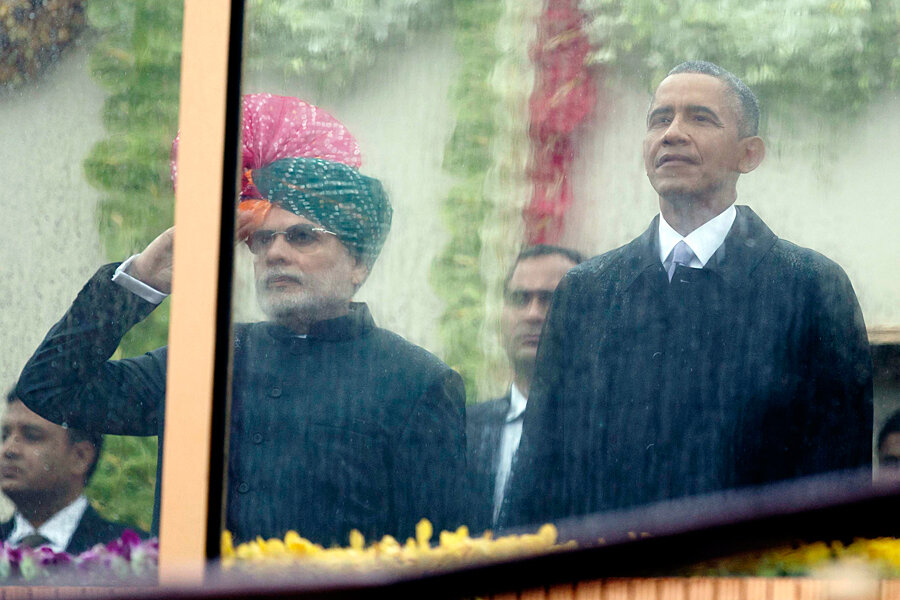Amid pomp on Delhi's King's Ave., signs of a changing US-India relationship
Loading...
| New Delhi
For the first time since India adopted its Constitution in 1950, a US president served as guest of honor for Republic Day celebrations, part of an effort to close a longstanding gap in relations in diplomacy, trade, and energy.
President Barack Obama's visit has gone swimmingly, though he will miss a trip to the Taj Mahal to attend a memorial for the Saudi king, and the American leader was filmed chewing gum during a military parade, causing a small buzz.
Mr. Obama and Indian Prime Minister Narendra Modi want to parlay what started as chummy relations this fall into stronger US-India ties, and Mr. Modi, in a last-minute change as host, took an extra step when Obama arrived by breaking protocol and personally going to the airport to greet him and First Lady Michelle Obama, amid hugs.
Hours later the two leaders announced a “breakthrough” making it easier for American firms to build nuclear reactors, a deal that has been stymied since 2008. They agreed to a military hotline, discussed US-Indian cooperation as the US leaves Afghanistan, and tomorrow a discussion taped today between Obama and Modi will go out on radio to the nation of 1.2 billion, reaching millions who don’t have a television.
Today, as part of the official celebration on Rajpath or King’s Avenue, Obama sat as Russian-made jets flew by and thousands of Indian soldiers in multicolored headgear passed by along with floats of tribal dancers and a mechanical lion whose purpose is to symbolize India’s desire to be a global manufacturing hub. For the first time, female contingents of the Indian Army, Navy, and Air Force marched down Rajpath as well.
Republic Day is akin to the US Fourth of July, marking the adoption of India's Constitution after it gained independence from Britain in 1947. Yet while Russian, British, Yugoslav, Japanese, and Saudi heads of state have presided over the event, an American has not.
China's state-run media Xinhua somewhat mocked the visit, saying the US and India would not quickly bridge their differences since Modi had been denied a visa entry to the US before he won elections last spring. On Sunday, in what may not be a coincidence, Pakistan, India's rival, sent its Army chief to Beijing for security discussions.
Modi promised to cooperate closely with the US on a global climate agreement at the end of this year in Paris. However no announcement has come on greenhouse gas targets close to the scale of the one Obama struck in November with China.
The Indian policy community has been quick to trump Obama’s visit as an enormous new symbolic feather in India’s cap.
“The India-US relationship has certainly entered into new space,” said Raja Mohan, analyst at Observer Research Foundation in Delhi. “[Prime Minister] Modi is changing the nature of India’s world view. He is departing from the Indian self-perception as a weak Third World nation that is afraid of engaging America.”
In the most substantial agreement – on nuclear plants – it is India that appears to have removed obstacles. India has 22 reactors and plans to build 40 more. On paper, Russia will build 20, France six, and India allocated land to the American firms of General Electric and Westinghouse for two more in the states of Gujarat and Andhra Pradesh.
Yet apart from the partial construction of one Russian reactor, no building on these projects has started.
The India-US nuclear deal has been pending eight years amid concerns by US firms over liability for a nuclear accident. American suppliers were wary of entering the Indian nuclear market after a 2010 nuclear liability law puts the onus on suppliers rather than operators in the event of an accident. The wariness is amplified by reluctance (on both sides) dating to the infamous chemical leak in Bhopal 30 years ago that killed thousands at Union Carbide’s factory and brought a contentious $470 million settlement.
This week India agreed to set up a $122 million insurance pool to shield affected operators and suppliers. Yet Bloomberg today quoted spokesmen for the US firms saying they still wanted to know more of the details. It remains to be seen whether American companies will be satisfied given that Section 46 of the nuclear deal still allows victims to sue those responsible for a nuclear accident.







